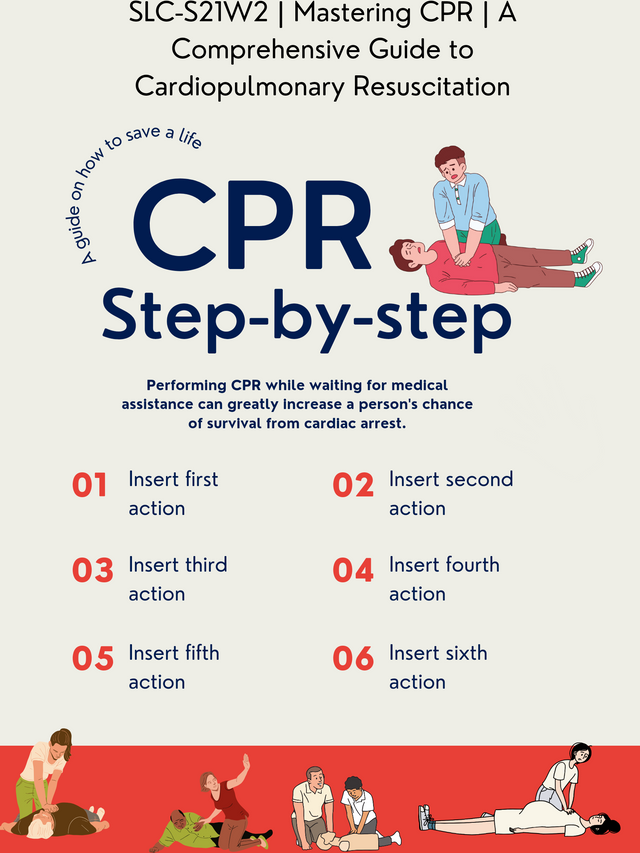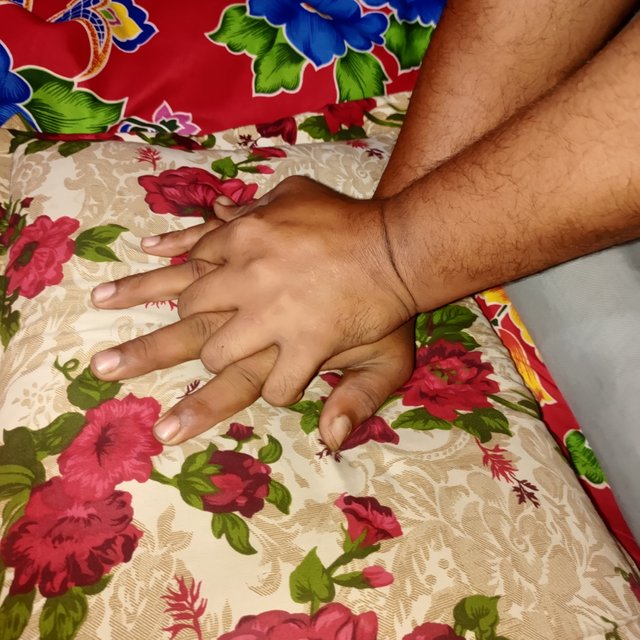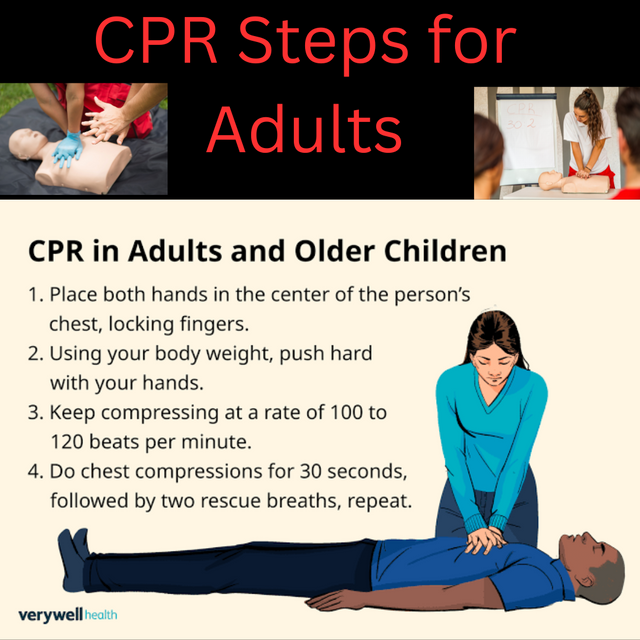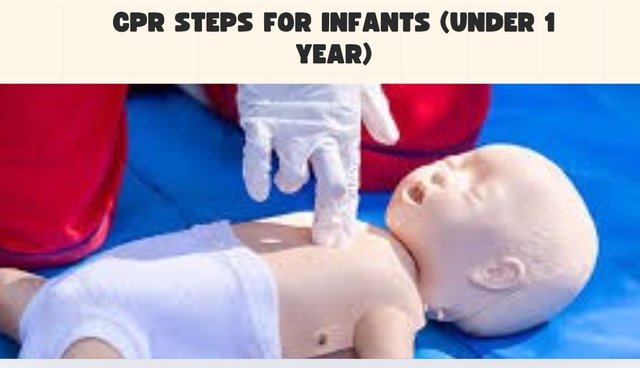SLC-S21W2 | Mastering CPR | A Comprehensive Guide to Cardiopulmonary Resuscitation
Assalam-o-Alaikum |
|---|

canva editing

QNo1 Perform all steps of cpr on a mannequin (your productivity) and explain each and every step in detail. Teach CPR to only 3 people (may it be your family, friends, relatives, or fellow mates and attach pictures of you teaching them)
(Edited- if you don’t have a mannequin, use a firm pillow or stack of towels)

CPR Training Guide: Saving Lives with Confidence
CPR which stands for Cardiopulmonary Resuscitation is an important method which makes the possibility of a man survival during the cardiac arrest much higher. Knowing CPR is paramount especially in emergency situations and the earlier somebody intervenes the better the outcome. Below is the additional step by step way that I have done on three family members with the help of a firm pillow stand in place of mannequin.

Step 1: Check for Scene Safety
As a advisable precaution, be certain that the surroundings are secure for you to be and secure for the needy person. Such risks as traffic, objects with a similar or higher height pose other risks that should be averted.
Step 2: Check Responsiveness
Tap the person lightly on the shoulders and then say, “Hey, are you alright?” If there is no answer then call the ambulance or tell someone else to do that as soon as possible.
Step 3: Check Breathing
Depress the head backward slightly to open the airway and look for normal breathing for 5-10 seconds. And if they are not breathing at all, or only occasionally, go ahead with CPR.
Step 4: Position Your Hands
Take your hand and put the heel of it on the centermost part of the chest, slightly above the sternum. Put your other hand on top creating an interlocking effect with the underhand. Make sure that your shoulders are over your hands and bend your arms at the elbow as tightly as possible.
Step 5: Perform Chest Compressions
Compress the chest hard and fast down to a depth of 5-6 cm in adults with the chest recoiling between each press. Ideally, keep a rate of 100-120 times per minute; it is helpful if someone counts out loud.
Step 6: Give Rescue Breaths
After training do 30 chest compressions followed by 2 rescue breaths by occluding the nostrils and sealing your mouth around the victim’s mouth and blowing hard enough to cause chest rise. : This step may be skipped if you only have to do the chest-compression-only CPR.
Step 7: Continue Until Help Arrives
Continue with 30 chest compressions followed by two rescue breaths until the siren stops or the person comes back to life.

I explained all the above steps to three of my family members and the three of us practiced it, each technician doing it with more confidence than the other. They became used to correct hand placement and were also able to practice the rhythm on a pillow. CPR is an important emergency skill that can save lives and with practice and time, anybody is able to get to the scene of the emergency.
QNo2 How to perform CPR on pregnant lady, obese people and weak elder people, write modifiable procedures for each in detail.
CPR on Pregnant Women, Obese Individuals, and Elderly People: Modifiable Procedures
It will also be important when it is applicable to change the normal standard operating procedure of CPR in case the targeted people have certain characteristics like pregnancy, obesity or frailty. Here’s how to adapt CPR for each group:
1. CPR on Pregnant Women
For pregnant women, CPR is even more complicated since the pregnant woman carries a fetus. Proper positioning and adjustments are crucial:
Positioning: Place the woman on her back, but roll her a little to her left side; put a rolled-up towel, blanket or pillow under her right forearm. This relieves pressure on the major blood vessels and thus increasing blood flow.
Chest Compressions: Make squeezes over the center of the sternum with your two palms. Deep and deliver fast (100-120 times per minute) with an inward pressure of approximately 5-6 cm.
Airway and Breathing: Continue with 30 compressions and two breaths in the same sequence. Check for an open airway and if capable give 2 looking for rise in the chest.
Emergency Response: If can do so, Lisle should let the emergency responders know about the pregnancy as soon as they are on the scene.
2. CPR on Obese Individuals
Instructed intrusions include; CPR on an obese person may need harder press due to additional weight, angle modification can enhance the CPR performance.
Positioning: Make certain that the person is on a stable ground and is standing on a level ground. Because of this, there may be required a heavy object or another person in order to give them a proper push.
Chest Compressions: Both hands, palms shaped in a fist, hand’s fingers up and touching the right side of the chest, left side of the chest respectively. Squeeze the press to get it to the necessary 2-inch depth. The rate should remain between 100 to 120 compressions per minute.
Airway and Breathing: If managing the airway is difficult, tip the head back slightly and open the mouth wide for the breaths to be delivered.
Consider Additional Help: If chest compressions are too hard to perform, ask for help or change the rescuers as fatigue weakens the intensity of the compression.
3. CPR on Elderly People
Some people have bones that break easily, or physiological conditions that require special attention when managing during CPR, and seniors are the most likely to have these complications.
Positioning: Place the individual to rest mouth down, on a rigid surface at the beginning of the procedure. Do not transfer them from one place to another frequently.
Chest Compressions: Perform chest compression at a rate of 100-120 compressions per minute and an amount of force to compress the chest to approximately two inches deep. Because the bones in her body are brittle, there is need not to put much pressure, but at the same time to achieve the right depth and speed.
Airway and Breathing: Approach the airway carefully and do not force it more than needed in order to open the airway. The performing of Thirty chest compressions and two rescue breaths forms the performance cycle.
Monitoring and Adjustments: Pay close attention to whether the limb is broken (fractured), and be prepared to adjust the force applied to the compression if your feel any resistance.
All these adaptations assists to ensure that the proper CPR is delivered to the patient while at the same time reducing any harm that might be caused due to the physical component of the patient.
QNo3 Write explanation for all the mistakes people do during CPR, aswe highlighted in the class topic.
Common Mistakes People Make During CPR
Performing Cardiopulmonary Resuscitation (CPR) accurately is critical to a patient's survival, but several common errors can reduce its effectiveness. Below are some key mistakes to avoid:
Inadequate Depth and Pace of Chest Compressions
One of the most frequent mistakes in CPR is performing compressions that are too shallow or too slow. For adults, compressions should be at least 2 inches deep and at a pace of 100–120 compressions per minute. Shallow compressions fail to circulate blood effectively, while compressions that are too rapid do not allow the heart to refill, limiting oxygen flow.Incorrect Hand Placement
Hand placement is essential for effective compressions. Hands should be positioned at the center of the chest, over the lower half of the sternum. Misplacing the hands too high or low can lead to broken ribs or even injuries to internal organs, compromising the quality of compressions.Incomplete Chest Recoil
Allowing the chest to fully recoil after each compression is crucial. This pause lets the heart refill with blood, increasing circulation. Without complete recoil, the effectiveness of each compression is reduced, decreasing the patient’s chance of recovery.Excessive Ventilation
Over-ventilation, which involves breathing too forcefully or too frequently, is another common error, especially among lay responders. Over-ventilation can increase pressure in the chest, reducing blood flow back to the heart. To avoid this, each rescue breath should last one second with just enough force to see the chest rise.Stopping CPR Prematurely
Stopping CPR before medical help arrives is a critical mistake. CPR should continue without interruption until professionals take over. Prolonged, continuous compressions maintain blood flow to vital organs, maximizing the patient’s survival chances.
By avoiding these common mistakes, individuals can greatly improve the effectiveness of CPR, giving the patient a better chance of recovery.
QNo4 Plan a simple campaign to raise awareness about CPR in your community. Write down the main goal of your campaign, who you want to reach (your target audience), and key messages you want to share. Think about how you can spread the word (like using social media or holding a community event). Your plan should be clear and include a basic timeline showing when you will do each part of the campaign. (You only have to devise a working plan and not practically implement it.)
Campaign Plan: CPR Awareness: A Community Problem
Campaign Goal: The focus of this campaign will be to raise awareness on when, how and why to perform CPR with an aim of saving more lives. The proposed solution is organised education and boosting the confidence level regarding performing CPR to have the community ready for action; action that could possibly mean the difference between life and death.
Target Audience: In our campaign we target all ages of the community members, but extra emphasis is placed on the:
- The target beneficiaries are youths aged between 18 and 35 years and students in primary and secondary schools.
- People who work with children, educators, and everyone who is takes care of children since they can be in emergencies.
- Patient’s carers as they are mostly found near patient’s residences where some types of emergencies may occur.
Key Messages:
- “CPR Saves Lives” – Focus and stress on how every person has the capability to help save another’s life in case of an emergency.
- “Learn CPR Today – Be a Hero Tomorrow” incentive the community to use a little of their time and become a hero to someone they love and other individuals.
- “Every Second Counts – Know the Steps of CPR” – Provide information on the critical timing of CPR and break down its basic steps: Check, Call, and Compress.
Campaign Activities & Timeline:
1. Week 1 – Social Media Launch and Awareness Building:
Some simple things you can do at the local level are: making interesting and informative posts, graphics and short videos that you would post on local social media promoting the following: Awareness of CPR facts and myths and real life journey stories and Testimonials where CPR made the difference.
Answer trivia questions and use other types of posts that call for sharing in the circle of the community’s followers.
2. Week 2 – CPR Training Session Promotion:
Promote the fact that there will be a free CPR training workshop soon through posters Around schools, malls, and clinics.
Involve clinics and other facilities of the local healthcare system as the pool of professionals to invite for practical demonstrations and to place training programs.
3. Week 3 – Community Event: CPR Workshop:
Organize an energetic practical class with instructors who will demonstrate and let the participants practice cardiopulmonary resuscitation on simulations.
Hand out small fliers or mini-leaflets which contain brief coverage of important steps to be taken in cases of cardiac arrest, and emergency numbers.
4. Week 4 – Follow-up & Sustained Engagement:
After the event, the CPR resource on the social media platforms includes a short CPR workshop recap video.
Organaization should promote social learning by asking members of the community to share their learning experiences with others in an effort to encourage other members to learn.
Through this series of LM, which is a one month long campaign, we hope to share the CPR knowledge and make people feel safer.
QNo5 Design a simple infographic (Illustration) that summarizing the basic steps of CPR for adults, children, and infants, including why CPR is important and list situations when CPR might be needed (like drowning or heart attacks).
Here's a structured plan for an infographic summarizing CPR basics:
Infographic Title: Cardiopulmonary Resuscitation :How to Save an Adult, Child or Baby
1. Why CPR is Important
Lifesaving Skill: While CPR involves chest compressions to maintain circulation of blood and oxygen to the brain and, it is widely known as Cardiopulmonary Resuscitation. The more time lost the worse the chances are; CPR can increase the odds of survival by two to three times.
2. When CPR Might Be Needed
Common Situations:
Cardiac Arrest: The condition that refers to the abrupt failure of the heart to pump blood effectively.
Drowning: When water conducts the airways:
Choking: Their use is recommended when the patient has a foreign object in the airway that has to be removed.
Severe Trauma: Severe conditions such as critical body injuries lead to car‘ death.’
Electrocution: Electric shock interferes wit the normal functioning of the heart.
3. CPR Steps for Adults
- Check Responsiveness: Tapping and shouting to see if is wakes up or reacts applies pressure.

made by canva
- Call for Help: Call emergency help and aim for an AED in case it is nearby.
- Chest Compressions: Put your hands in the center of the chest and push hard and fast (between 100 and 120 times per minute).
- Rescue Breaths: Give 2 breaths after every 30 compressions if you have been trained.
4. CPR Steps for Children 1 Year and Older
- RIIII Check Responsiveness and CALL FOR HELP.
- Position Hands: Shall use one hand if the child is small and two if needed to have deep pressure for chest compressions.
- Chest Compressions: Thirty vectors and then two puffs.
5. CPR Steps for Infants (Under 1 Year)
- A warm Check Responsiveness is performed by gently tapping the patient’s foot.

made by canva
- But if you’re alone, call for help but begin doing CPR if help has not arrived yet.
- Positioning: Put two fingers in the middle of the chest.
- Compressions and Breaths: 30 gentle jabs followed by 2 breaths.
Note: As mentioned before do not forget to emphasize that each age group is different, for instance, an adult’s hand positioning would be different from those of a child or a baby.

i would like to invite @patjewell @josepha @beautiful12 to take part in this contest
Organizer Dr @abdu.navi03 Dr @huzaifanaveed1
Regard For me @Shabbir86

Student Name @shabbir86
Overall Grade 8.1/10
Plagiarism Check Pass
AI Use No
General Feedback
The student showed a strong understanding of CPR and its adaptability, applying practical techniques in their explanations. Their use of visual aids was commendable and helped clarify essential steps. Moving forward, adding more structured visuals and a deeper dive into physiological details could further enhance their work. Excellent effort overall!
Regards
@abdu.navi03
0.00 SBD,
10.80 STEEM,
10.80 SP
Maybe the initial graphic should not have 'Insert first action', 'Insert second action' etc...
cc @abdu.navi03 @huzaifanaveed1 @shabbir86
Upvoted! Thank you for supporting witness @jswit.
X Permotion
https://twitter.com/shabbir_saghar/status/1855656780635754826?t=hoaZawUrHIVE6tYfzRN_eA&s=19
Assalam Alaikum Steemit team is asking you to check the post in 24 hours while my post is going to be completed on the third day but still my post is not reviewed what is the reason you should note this. And review the post on time as the Steemit team has given you time.
@steemitblog
@steemcurator01
@steemcurator02